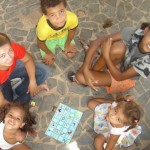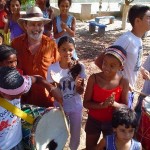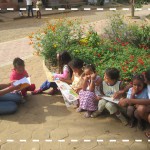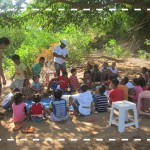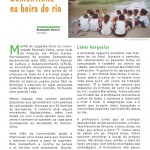
- Home
- Who we are
- Initiatives
- 2023
- 2022
- 2021
- 2020
- 2019
- Acreditar
- Capão’s Citizen Association
- CENEP
- ClareArt Association
- Dreaming Project Institute
- Interference
- Nursery Walk With Love is the Solution
- Organic Outskirts
- Panthers’ Productions Collective
- Sementinha Project (Little Seed) – Year 5
- Stitch to Stitch Collective
- The Story Finders Collective
- Untangle and Don’t Fool Me Collective
- 2018
- 2017
- 2016
- 2015
- 2014
- Partners
- Network and Territory
- Transparency
- Publications
- Make a donation!
Sementinha Project (Little Seed) – Year 1
Photo Gallery
CPCD
CPCD is a non-governmental organization (NGO) founded in the year of 1984, in the city of Belo Horizonte, state of Minas Gerais, by Tião Rocha, an educator and anthropologist. CPDC was created to act in Popular Quality Education and Sustainable Community Development, using Culture as a raw material and as a pedagogical and institutional working tool.
Its mission is to be a permanent learning institution in the fields of Education and Development, using Culture as raw material and as an action tool.
Since 1984, CPCD strives to implement and accomplish innovative projects, integrated programs and Social Transformation and Sustainable Development platforms, which are intended for communities and cities with less than 50.000 residents where 90% of the Brazilian population lives.
CPCD and Fundação ABH partnered up to initiate the Projeto Sementinha in Chácara Santo Amaro (Grajaú district) in the city of São Paulo, São Paulo State.
When building a Healthy Community seeds are spread in many directions.
In a territory formed by children, young adults, women, families with accumulated knowledge, dreamed dreams and available potential, possibilities are diverse and promising.
One of the possibilities is to mobilize mothers and along with them assist their small children with the participation of the entire community.
From that moment on, the territory worth is recognized, cultural memories are revived, values are reaffirmed, bridges are built and changes occur.
Sementinha Project (also known as “The school under the mango-tree”) is a pre-school educational initiative, intended for kids between the age of 4 and 5, who were not assisted by public or private schools. This project began in Curvelo, Minas Gerais State, in 1984, to assist children in need. After that, the project was developed in Araçuaí/MG, São Francisco, MG, Porto Seguro/BA, Santo André/SP and Pinheiro/MA and, more recently, in Chácara Santo Amaro/SP!
The project goals are as follows:
- To create a new teacher-and-student concept;
- To build an innovative education practice.
To achieve these goals a methodology was developed in order to:
- foster “dialogue” as a moderator in relationships among participants
- prioritize respect for individual differences
- value individual know-how
- seek collective and educational solutions for all issues experienced by the participants
- build an open, plural and democratic education
- transform every occupied environment into a “school” and every “school” into a “community culture center”
In short, Sementinha Project can be defined as:
- School-environment is the neighborhood;
- School-content is the community culture;
- An educator is everyone who participates in the educational process.
The educational process is guided by the following steps:
The circle: All school / educational activities begin with a “circle” at the “meeting point”. There, educators and learners gather to talk, tell the news, plan, discuss and evaluate. The “circle” is, at the same time a symbol of organization and an instrument of work.
The Agenda: “Agenda” means planning together: establishing priorities, organizing the paths to track, defining actions. All – educators and learners – participate and contribute to the development of the agenda: what will be studied, where, how, with whom, until when, etc.
The evaluation: At the end of each day, the circle gathers again to “evaluation”: what has been done, the results achieved, the challenges faced, the unresolved issues, the participation, the progress, the failures, etc.
The Memoir: All the experiences are recorded in different forms – written, drawn, sung, sculpted, spoken, etc. It is up to the coordinators to organize this “memoir”. This material will be used as reference for all Project participants, and will be considered, at the same time, as the building of the history of this work.
Understanding education as something plural in which we all act as educators and learners provided the basis for the development of the methodological actions:
- the search for creative and innovative ways of stimulating participation (the circle, games, play activities, etc.)
- the appraising of knowledge and actions (the culture of the child and the community as raw material and instrument of pedagogical action)
- the dialogue as a generative principle of a plural educational practice and guiding of more humane and equal relationships.
Educator Qualification: Forming people is both difficult and challenging; this challenge becomes greater when the intent is to form an educator-people. That is why the entire training process emphasized the training of educators as “provocateurs” and “opportunity-makers”, not as “owners of knowledge.” The outcome is the existence up to this date, of militant teams, committed and aware of their social function in the municipalities where this project was implemented.
Community Involvement: The participation of the community, not as an object, but as a player on the educational process of its children, enabled the rooting and consolidation of the proposal. The project is now an integral part of community life where it has already been implemented. People have discovered in it a possibility of organization and an instrument of its development, that is, the project as a generator of opportunities and perspectives for the children and their families.
2015 RESULTS
Training of Educators
The training started with Tião Rocha on October 13, 2015 and following it was joined by the General Coordinator of the CPCD Eliane Almeida and educator Onésima Mourthé. The training had a total of 160 hours and aimed to develop the group so it could become a team of popular educators and play the building game of an educational community, through the implementation of the Sementinha (Little Seed) Project.
In addition to pedagogical learning, group dynamics, games, playful activities were experienced and discussed. Similarly, tools of the Popular Center for Culture and Development (CPCD), such as MDI, in how many different and innovative ways can we? and the PTA – Work Plan and Project Evaluation were used. The training also provided several practice moments, with workshops on earth paint, toy creation, construction of a neighborhood model and discussion of possibilities for local transformation, through working with children and their families.
The training had the participation of 35 persons and ended on November 7 with a total of 15 individuals. They all got involved in the activities with great curiosity and dedication to each proposal presented. In the toy workshops it was possible to note a lot of commitment and whimsy in each piece built.
FIELD WORK BEGINNING
At the end of this first phase of formation, seven educators were selected and work began in the community of Chácara Santo Amaro. In the period from November 9 to November 13 the group of educators, the coordinator and an educator of the CPCD-MG dedicated themselves to visit the houses and enroll the children to participate in the Sementinha project.
Two work groups were formed; one in Vila da Paz and another in Vila do Sapo and Parada Obrigatória, counting on five of the seven educators. Activities with children began on 16 November.
At the beginning the participation was moderate, possibly due to the fact that it was new to see Sementinha working with children in the various environments of the villages. However, the important thing is that the educators welcomed and involved the children developing with them several activities.
Children have a daily routine which consists of meeting in the arranged spots, having snacks in some place (resident’s house, Residents’ Association room, neighborhood community environments) and then move on to the activity varying according to what they have agreed in the community. The activity could be a playful activity, visitation to the home of some resident, workshops, etc. These meetings begin at 7:30 am and end at 11:00 am. Every Friday the team meets to evaluate the week and discuss the activities for the coming week.
The project was supported by the CPCD Coordinator in Vargem Grande, who was present in the groups up to twice a week and participated in the team meeting. In addition, the group had the contribution of another educator from the CPCD, who came from Minas fortnightly to accompany and collaborate with the development of the work in the neighborhood, remaining for a period of fifteen days.
In order to develop the actions together with the residents, there is a monthly meeting to discuss the agenda with suggestions of activities and places to develop them. When they meet as the circle, everyone contributes with their knowledge and desire and such contribution gives rise to the workshops and who will be involved in them, at what time and where they would happen.
Gradually the community started to open itself and the boys and their families got closer. Residents who were willing to teach percussion workshops, storytelling were also located and opened their doors to receive children and educators.
In the first fortnight, the agenda was formed along with the children, the educators of the CPCD, the coordination and some institutions of the neighborhood (Residents’ Association, CCA and some residents with whom the educators had contact with). The important thing was to start the activities and show the families and the community, which was still a little suspicious, what the project actual purpose was.
After some time carrying out activities around the neighborhood, on December 02 the community was invited to form the “agenda”. The result of this meeting was very positive, as the parents and grandparents of the children who participated, UBS representative, the principal and vice principal director of the neighborhood school, the vice president of the Residents’ Association and two pastors attended. After watching an interview where Tião Rocha spoke about the Sementinhas Project, the floor was given for those who had questions and suggestions. The Association opened its doors, offering the space for activities with the groups; the school offered a room for workshops and the sports court and the entire school facilities on weekends for the whole community; UBS also proposed to work with workshops, offering space for movies and thematic films involving environment and environmental education, as well as the garden and vegetable space. The meeting ended with a delicious snack and the draw of a Christmas décor piece and two CPCD recipes books.
DEVELOPED ACTIVITIES
SNACK
Every time together is used as a learning experience. It could not be different when it is snack time. The meal is planned based on a healthy menu (sandwiches, cakes, pastries, teas, milk, juices and fruit). It is shared in the group equally and it is a time to discuss healthy eating habits.
TOY WORKSHOPS
This activity is used to develop motor coordination in the children, helping them to identify colors, discover the result of color mixing, concentration, self-esteem, self-government, creativity and care for the environment.
The wooden spinning top was a toy that made a lot of success among the children. A fun toy could be manufactured by using cardboard, crayon and a piece of barbecue stick and the best part is that each child got to build her own. The groups also got to build another toy called the spider. This is a fun toy built by using the bottom part of a pet bottle. Each child could use their creativity to decorate their pet.
To build the “piaba” (a type of kite) the children used newspaper, crayon and string. The cordless telephone, made out of yogurt cups and string, was a way to get the kids to talk to each other and to the educators, making them more involved in the group. As a result, we were able to encourage the children’s verbal communication, imagination and a good coexistence.
MUTUAL-AID CLEANING EFFORT
With the objective of discussing with children about the care with the space, places they go to, the court and surroundings, the group was encouraged to carry out a mutual-aid cleaning effort where they collected pet bottles and plastic bags. They used the bottles to make the toy “Spider” and then planned a fun race with the toy.
PLAYFUL ACTIVITY
The playful activities employed each day in the project are important tools of work. To deepen the friendship, discuss the space in which they are inserted, the care and respect they must have for each other, to develop the imagination, the spirit of collaboration, socialization and to have a better understanding of the world.
In the Project the ground is the paper and the stick the pencil, that serve to put the world in letters, scribbles and images of the daily life for each one of the children.
In the simplicity of the popular play of “button, button, who’s got the button?”, children have the opportunity to discuss and experience the wait in turn, respect with others, attention and care.
In “Watermelon” play, a lively music, the gestures are according to the body parts.
In Round Songs children are encourage to develop imagination, logical reasoning, exercise the body, use collective work, and understand the self and us and use memory.
Gradually the community opens itself to embrace the meaning of the Sementinha Project, which is still a work quite abstract in the eyes of the residents that look at the actions with a certain distrust, but with the desire to see their children happy and enjoying freedom within the community.
Some residents have already demonstrated full support for the actions by offering to share their knowledge and skills with the children; this interaction and openness has already provided a syrup workshop, as well as possibilities for storytelling, percussion workshops, soccer, among others.
CHALLENGES:
At the outset, the challenge was to convince families that it was safe for their children to develop activities on the streets, to visit other homes, to share snacks in public environments, to use restrooms in other homes.
The current challenge is to increase the number of children. Educators are visiting the houses again and holding meetings with local institutions and leaders. The UBS nurse made a commitment to talk with the residents and share the Project with the families.
Want to know more about the Sementinha Project? Access the links below:
http://www.cpcd.org.br/projeto-sementinha-comunidade-educativa/
http://www.cpcd.org.br/videos/projeto-sementinha-mobiliza-brasil-2003-video_ddddbb572.html
http://www.cpcd.org.br/videos/projeto-sementinha-tamanho-familia-parte-1-2003-video_306ddc12a.html
http://www.cpcd.org.br/videos/projeto-sementinha-tamanho-familia-parte-2-2003-video_e0f8c897d.html
http://www.cpcd.org.br/videos/projeto-sementinha-tamanho-familia-parte-3-2003-video_e3cfb201d.html
http://ceapg.fgv.br/sites/ceapg.fgv.br/files/u26/relatorio_cpcd1.pdf
http://www.salvemascriancas.org/wp/?p=463
http://educacaointegral.org.br/wp-content/uploads/2013/08/Guia_IQP.pdf
http://www.inclusive.org.br/?p=22581
http://www.scribd.com/doc/16491842/2009-Relatorio-Fotografico-Sementinha-Curvelo-FEV-ABR-09#scribd
http://docvirt.com/docreader.net/DocReader.aspx?bib=tematico&pagfis=52612&pesq=
(the above links refer to Sementinha Project in different places around Brazil, including the one in Chácara Santo Amaro/SP).
Testimonies
“Sementinha School differs from all other schools. It is the most beautiful thing in the neighborhood. Children talk to us about everything, they don’t learn only the alphabet, they learn about life and their ideas are evolving. Sementinha is not like other schools, where a black person is an outcast, standing in the corner and a white or a rich person is the best. Here, the dirty, the outcast and the black kid are all embraced, we are all equals.” (Maria Geralda Gomes, a 44-year-old mother from Itasa neighborhood, São Francisco, Minas Gerais State.)
“In our home, we have a good family interaction and the project contributes to making it increasingly better. My daughter was shy and now she has loosened up, and I have started to give her more attention. She tells me that her class is united and that she enjoys participating in everything. I get very involved with the project, I state my opinions and I always attend the meetings.” (Maria D’ajuda Nunes, a 40-year-old mother from Gravatá II, a neighborhood in Porto Seguro, Bahia State.)
“My son has changed a lot. He was very aggressive towards his brothers and would not stay home. Now he is calm and even enjoys teaching his brothers what he learns in the project, he is more obedient and, most importantly, he learned how to be polite to others. I know that in the project children have a lot of opportunities to learn how to live in society and how to become more civilized. In the future, I hope my son has more friendships, love and freedom.” (Maria de Jesus Silva, a 38-year-old mother from Gravatá II neighborhood, in Porto Seguro, Bahia State.)
“Things are discussed and solved taking into account limits and difficulty levels. All alternatives are tried and analyzed, seeking to improve the level of comprehension and quality of life. The coordinators are tireless when searching for solutions to problems. Even when they are personal problems, as soon as they are brought up, they become objects of discussion in the search for solutions.
The project opened up a range of possibilities for the team which are being used and have not yet been exhausted. The willingness to overcome all obstacles makes this team a never-ending source of courage.
My relationship with the children is great. When I arrive at the meeting point or anywhere else, the children run and hug me.” (Vânia Lucia Coutinho, Coordinator for the Projeto Sementinha Porto Seguro, Bahia State.)
“The change project makes in the lives of the children and the community is that they start to value what they do and relate much better to each other. In addition, everything we do is creative and there is a lot of concern in finding new ideas and playful activities; everything that can make the project to become more interesting. I give my all to come up with new ideas and sometimes I feel like I am the owner of the project because everything I do for it is to the benefit of seeing it improve and growing.” (Elisângela do Santos Gomes, an educator of Projeto Sementinha in Porto Seguro, Bahia State.)
“Beauty is not prominence in our work. The life inside is what matters, inner beauty and good deeds. If we produce something beautiful with willingness and dedication, then it must be valued. The project produces truly beautiful things from recyclable materials. The project bestows the poor individual the value he has, teaching him self-respect and showing the true value of things. The project needs interested and skilled people that like what they do, so that it can develop and grow.” (Vandelina, an educator of Projeto Sementinha Porto Seguro, Bahia, State.)
“I think everything you do is important. These children would wander around the streets without any supervision, but now I know that they are with you. I don’t worry because I know they are learning a lot.” (Onofre Batista Cruz, a 56-years-old father from Vila Vicentina, in São Francisco, Minas Gerais State.)
“Over time we came to know each child´s home, through tea and school meal time. Every mother willingly participates; they talk in the circle and the children feel comfortable wherever we are.” (Geane Gomes de Araújo, an Educator of Bairro Bandeirantes from São Francisco, Minas Gerais State.)
“We grow, because the project stirs us up all the time.” (Marciene Chaves Lima, Educator, Bairro Aparecida from São Francisco, Minas Gerais State)
“My kids feel they own the project, they are cheerful and say that when the project is happening it is very good… that the coordinators treat them in a loving way; this is good because, in the past, teachers used to be aggressive when teaching the children.
Teachers from the project teach with love. My daughters are changing and for the best. My dream is to throw a party for children of the Sementinha as a thank you for all the good the project has done for my family.”(Nivaldo, a 41-year-old father, Bairro Gravatá I from Porto Seguro, Bahia State.)
These testimonies refer to other Projetos Sementinha in different places around Brazil, because Projeto Sementinha Chácara Santo Amaro was just launched and did not have its own testimonies at that time.




